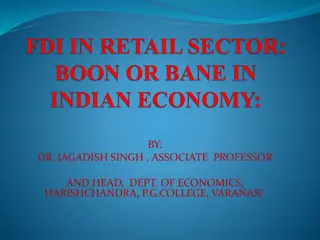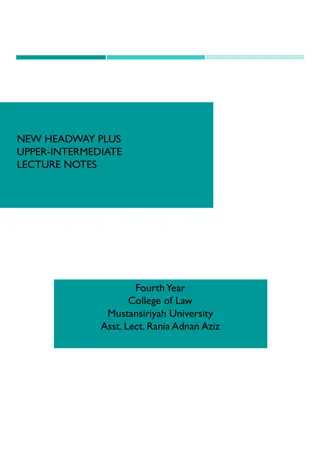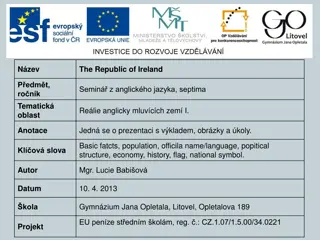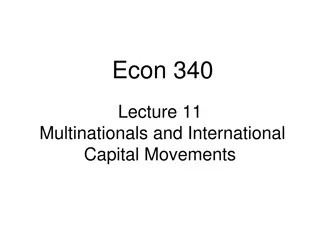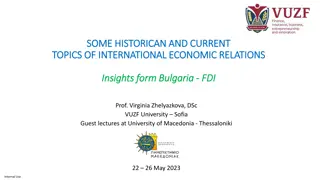Evolution of FDI Intensity in Ireland from Past to Present
Ireland's history of FDI dates back to the early 20th century, with major successes like Ford Motor Company setting up production. The sectoral distribution of FDI under protectionism showed a focus on advertising and R&D-intensive sectors. Foreign firms had a minor employment share in certain industries, while others like chemicals and electrical equipment dominated. Today, FDI in Ireland continues to evolve in various sectors, reflecting past trends and current global contexts.
Download Presentation

Please find below an Image/Link to download the presentation.
The content on the website is provided AS IS for your information and personal use only. It may not be sold, licensed, or shared on other websites without obtaining consent from the author.If you encounter any issues during the download, it is possible that the publisher has removed the file from their server.
You are allowed to download the files provided on this website for personal or commercial use, subject to the condition that they are used lawfully. All files are the property of their respective owners.
The content on the website is provided AS IS for your information and personal use only. It may not be sold, licensed, or shared on other websites without obtaining consent from the author.
E N D
Presentation Transcript
Evolution in Irelands FDI Intensity Frank Barry Professor of International Business and Development Trinity College Dublin
Irelands current FDI intensity in international comparative context
But Ireland has a longer history of FDI that most people suppose! Ireland s first major FDI success Ford Motor Company began tractor production for export in Cork in 1919 Employed almost 6,000 in 1929 Still employed 1,000 in the 1950s
Substantial Tariff-Jumping FDI from 1920s to 1950s
Players and Wills (cigarettes) set up Irish factories in the early 1920s 1,500 employed between them c. 1960 Cadburys (1932) 2,000 employed c. 1960 Irish Dunlop (1934/5) 1,300 employed c. 1960 Clarks Shoes (1938) 1,000 employed in Irish partner firm c. 1960
What was the sectoral distribution of FDI under protectionism? Evidence suggests no general principle in sectors attracting outside penetration 1928 report on foreign ownership by Department of Industry and Commerce Expansion of foreign-owned industry in the 1920s resulted from changing market demand, in particular the growing importance of advertising, which led to the emergence of large conglomerates in consumer industries Historian Mary Daly (1992)
In fact, exactly as today, FDI congregated in advertising-intensive and R&D-intensive industrial sectors Even in the protectionist era Foreign firms accounted for insignificant shares of employment in sectors such as Wood and Furniture, Paper and Printing, Non-Metallic Minerals, Iron and Steel Manufactures Accounted for the bulk of employment in sectors such as Chemicals, Electrical Equipment and Apparatus, Wireless TV and Telecommunications Equipment
In the mid-1950s (before trade liberalisation), Ireland stumbled on its low corporation tax strategy of attracting export-oriented industry: export profits tax relief
New Faber-Castell Factory in Fermoy, mid-1950s
Sectoral distribution of foreign-firm manufacturing employment 1973 24 19 8 4 2010 11 0 24 5 Food, Beverages and Tobacco Textiles, Clothing and Footwear Chemicals (including Pharma) Machinery and Equipment Electrical and Electronic (including Office and Data Processing) Medical Devices Transport Equipment Remainder 5 21 4 11 24 25 3 11
Employment in foreign-owned manufacturing and foreign-owned internationally-traded services 1991 2010 Foreign-owned manufacturing 89,167 80,089 Foreign-owned internationally-traded services 7,398 59,110
Interactions between different tax jurisdictions have become increasingly complex MNC transfer pricing issues Increasing importance of intellectual property Rival tax philosophies of Democrats and Republicans in the US Caribbean tax havens and the geographic architecture of US MNCs
Notwithstanding the fact that foreign MNCs use substantial inputs of Irish services, they are also huge importers of intermediate goods and make huge royalty and licence payments abroad. For Ireland, royalty and licence payments abroad are about as large as computer services exports
Conclusions Because of the huge import content associated with global production sharing, export data are much less revealing than they once were The rules of how we measure revealed comparative advantage need to be rewritten










